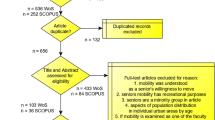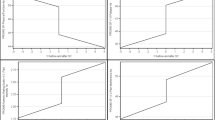Abstract
Quality of Life (QoL) is frequently understood as subjective well-being at both individual and population levels and specific to a country or context. For individuals, mobility afforded by transport is an important predictor of QoL. This paper aims to provide an overview of theoretical approaches, particularly the selection, optimization, compensation (SOC) model, the scales used to measure quality of life, and the scale development of Mobility-related Quality of Life (M-QoL) among older drivers. A pool of items was developed from three sources: i) literature review, ii) Instrumental Activities of Daily Living (IADL) scale and iii) focus group discussion with older drivers. A survey amongst 498 older Malaysian drivers was administered to confirm internal consistency of the scale. Exploratory factor analysis revealed that the developed M-QoL scale consists of 12 items with good internal consistency (α = 0.90), and consists of two subfactors addressing functions of driving and accessibility for independent living. Implications of the findings are discussed, including encouraging continuation of driving for those who are able to drive safely, and provision and use of alternatives to driving to help them achieve maximum mobility. Suggestions for future research are also recommended.
Similar content being viewed by others
References
Adams, R. J., Wilson, D. H., Taylor, A. W., Daly, A., d’Espaignet, E. T., Dal Grande, E., & Ruffin, R. E. (2004). Psychological factors and asthma quality of life: A population based study. Thorax, 59(11), 930–935.
Alesii, A., Mazzarella, F., Mastrilli, E., & Fini, M. (2005). The elderly and quality of life: Current theories and measurements. Giornale Italiano di Medicina del Lavoro ed Ergonomia, 28(3 Suppl 2), 99–103.
Baldock, M. R. J., Mathias, J. L., McLean, A. J., & Berndt, A. (2006). Self-regulation of driving and its relationship to driving ability among older adults. Accident Analysis & Prevention, 38, 1038–1045.
Baltes, P. B., & Baltes, M. M. (1990). Psychological perspectives on successful aging: The model of selective optimization with compensation (pp. 1-34). In P. B. Baltes & M. M. Baltes (Eds.), Successful aging: Perspectives from the behavioral sciences. Cambridge, UK: Cambridge University Press.
Bowling, A. (2009). The psychometric properties of the older people's quality of life questionnaire, compared with the CASP-19 and the WHOQOL-OLD. Current Gerontology and Geriatrics Research, 1-12.
Bowling, A., & Stenner, P. (2010). Which measure of quality of life performs best in older age? A comparison of the OPQOL, CASP-19 and WHOQOL-OLD. Journal of Epidemiology and Community Health, 65, 273–280.
Burckhardt, C. S., & Anderson, K. L. (2003). The quality of life scale (QOLS): Reliability, validity, and utilization. Health and Quality of Life Outcomes, 1, 60.
Charlton, J. L., Oxley, J., Fildes, B., Oxley, P., Newstead, S., Koppel, S., & O’Hare, M. (2006). Characteristics of older drivers who adopt self-regulatory driving behaviours. Transportation Research Part F: Traffic Psychology and Behaviour, 9(5), 363–373.
Child, D. (2006). The essentials of factor analysis (3rd ed.). New York: Continuum International Publishing Group.
Costello, A. B., & Osborne, J. W. (2005). Best practices in exploratory factor analysis: Four recommendations for getting the most from your analysis. Practical Assessment Research & Evaluation, 10(7), 1–9.
Coughlin, J. & Public Policy Institute (2001). Transportation and older persons: Perceptions and preferences: A report on focus groups. AARP, Public Policy Institute.
Crouchley, K., & Daly, A. (2007). Chronic disease and quality of life in Western Australia. Western Australia: Department of Health.
Fang, J., Power, M., Lin, Y., Zhang, J., Hao, Y., & Chatterji, S. (2012). Development of short versions for the WHOQOL-OLD module. The Gerontologist, 52(1), 66–78.
Field, A. (2013). Discovering statistics using IBM SPSS statistics. Sage Publication.
Gabriel, Z., & Bowling, A. (2004). Quality of life from the perspectives of older people. Aging. Society, 24, 675–691.
George, D., Mallery, P. (2003). SPSS for Windows step by step: A simple guide and reference. 11.0 update (4th ed.). Boston: Allyn & Bacon.
Graf, C. (2009). The Lawton instrumental activities of daily living (IADL) scale. The Gerontologist, 9(3), 179–186.
Guyatt, G. H., Feeny, D. H., & Patrick, D. L. (1993). Measuring health-related quality of life. Annals of Internal Medicine, 118(8), 622–629.
Hakamies-Blomqvist, L., Sirén, A., & Davidse, R. (2004). Older drivers-a review. Sweedish National Road and Transport Research Institute, VTI rapport 497A.
La Grow, S., Alpass, F., Stephens, C., & Towers, A. (2011). Factors affecting perceived quality of life of older persons with self-reported visual disability. Quality of Life Research, 20(3), 407–413.
Liang, W. M., Chang, C. H., Yeh, Y. C., Shy, H. Y., Chen, H. W., & Lin, M. R. (2009). Psychometric evaluation of the WHOQOL-BREF in community-dwelling older people in Taiwan using Rasch analysis. Quality of Life Research, 18(5), 605–618.
Metz, D. H. (2000). Mobility of older people and their quality of life. Transport Policy, 7, 149–152.
Mezuk, B., & Rebok, G. W. (2008). Social integration and social support among older adults following driving cessation. Journals of Gerontology Series B: Psychological Sciences and Social Sciences, 63, S298–S303.
Sharifah Norazizan, SAR., Hamid, T.A., Chan, Y. F, & Hussain, M. R. (2006). Promoting health ageing in healthy cities: Activities, access and ageing in Malaysia. Turkish Journal of Geriatrics, 9, S1, p28.
OECD. (2001). Ageing and transport: Mobility needs and safety issues (pp. 1–125). Paris: Organization for Economic Co-operation and Development Publications.
Osborne, J. W., & Fitzpatrick, D. C. (2012). Replication Analysis in Exploratory Factor Analysis: What it is and why it makes your analysis better. Practical Assessment, Research & Evaluation, 17, 15 Available online: http://pareonline.net/getvn.asp?v=17&n=15.
Ouwehand, C., de Ridder, D. T., & Bensing, J. M. (2006). A review of successful aging models: Proposing proactive coping as an important additional strategy. Clinical Psychology Review. https://doi.org/10.1016/j.cpr.2006.11.003.
Oxley, J., & Charlton, J. (2009). Attitudes to and mobility impacts of driving cessation: Differences between current and former drivers. Topics in Geriatric Rehabilitation, 25(1), 43–54.
Oxley, J., & Whelan, M. (2008). It cannot be all about road safety: The benefits of prolonged mobility. Traffic Injury Prevention, Special Issue on Older Road Users, 9(4), 367–378.
Paschoal, S. M., Filho, W. J., & Litvoc, J. (2008). Development of elderly quality of life index-EQOL: Item reduction and distribution into dimensions. Clinical Science, 63(2), 179–188.
Power, M., Quinn, K., & Schmidt, S. (2005). Development of the WHOQOL-old module. Quality of Life Research, 14(10), 2197–2214.
Ragland, D. R., Satariano, W. A., & MacLeod, K. E. (2004). Reasons given by older people for limitation or avoidance of driving. The Gerontologist, 44, 237–244.
Raitanen, T., Tormakangas, T., Mollenkopf, H., & Marcellini, F. (2003). Why do older drivers reduce driving? Findings from three European countries. Transportation Research Part F: Psychology and Behaviour, 6, 81–95.
Rantakokko, M., Portegijs, E., Viljanen, A., Iwarsson, S., Kauppinen, M., & Rantanen, T. (2015). Changes in life-space mobility and quality of life among community-dwelling older people: A 2-year follow-up study. Quality of Life Research, 1-9.
Rubin, R. R., & Peyrot, M. (1999). Quality of life and diabetes. Diabetes/Metabolism Research and Reviews, 15(3), 205–218.
Sexton, E., King-Kallimanis, B. L., Conroy, R. M., & Hickey, A. (2013). Psychometric evaluation of the CASP-19 quality of life scale in an older Irish cohort. Quality of Life Research, 22(9), 2549–2559.
Wahl, H. W., Mollenkopf, H., Oswald, F., & Claus, C. (2007). Environmental aspects of quality of life in old age: Conceptual and empirical issues. In Quality of life in old age (pp. 101–122). Springer Netherlands.
Wiggins, R. D., Higgs, P. F. D., Hyde, M., & Blane, D. B. (2004). Quality of life in the third age: Key predictors of the CASP-19 measure. Ageing and Society. https://doi.org/10.1017/S0144686X04002284.
Yeoh, S. F., Ibrahim, R., Oxley, J., Hamid, T. A., & Rashid, S. N. S. A. (2016). Development of a valid measurement instrument to understand self-regulatory driving practices among older drivers in Malaysia. Accident Analysis & Prevention, 92, 1–8.
Zebrack, B. J., & Chesler, M. A. (2001). A psychometric analysis of the quality of life-cancer survivors (QOL-CS) in survivors of childhood cancer. Quality of Life Research, 10(4), 319–329.
Acknowledgements
This study was supported and funded by “Exploratory Research Grant Scheme, Ministry of Higher Education (Project number: ERGS/1/2012/SS08/UPM/02/36) to develop scale and model of Self-Regulatory Driving Practices among Older Malaysian Drivers.
Author information
Authors and Affiliations
Corresponding author
Ethics declarations
Conflict of Interest
The authors declare no conflicts of interest.
Informed Consent
Informed consent was obtained from all individual respondents recruited in the project.
Ethical Treatment of Experimental Subjects (Animal and Human)
All procedures performed in studies involving human participants were in accordance with the ethical standards of the institutional and/or national research committee and with the 1964 Helsinki declaration and its later amendments or comparable ethical standards. The survey form of project was also approved by the Universiti Putra Malaysia ethics committee, Malaysia.
Rights and permissions
About this article
Cite this article
Yeoh, S.F., Oxley, J., Ibrahim, R. et al. Measurement Scale Development for Mobility-Related Quality of Life among Older Malaysian Drivers. Ageing Int 43, 265–278 (2018). https://doi.org/10.1007/s12126-017-9310-x
Published:
Issue Date:
DOI: https://doi.org/10.1007/s12126-017-9310-x




